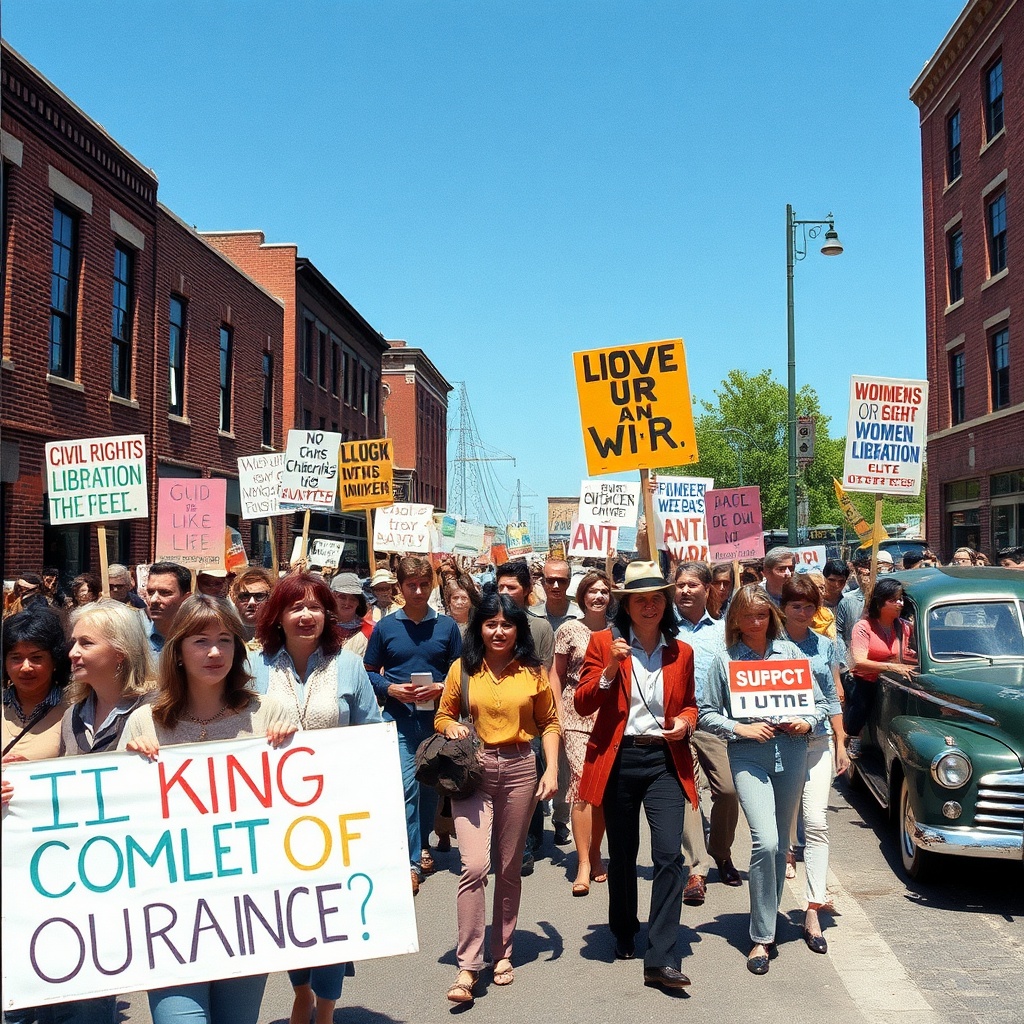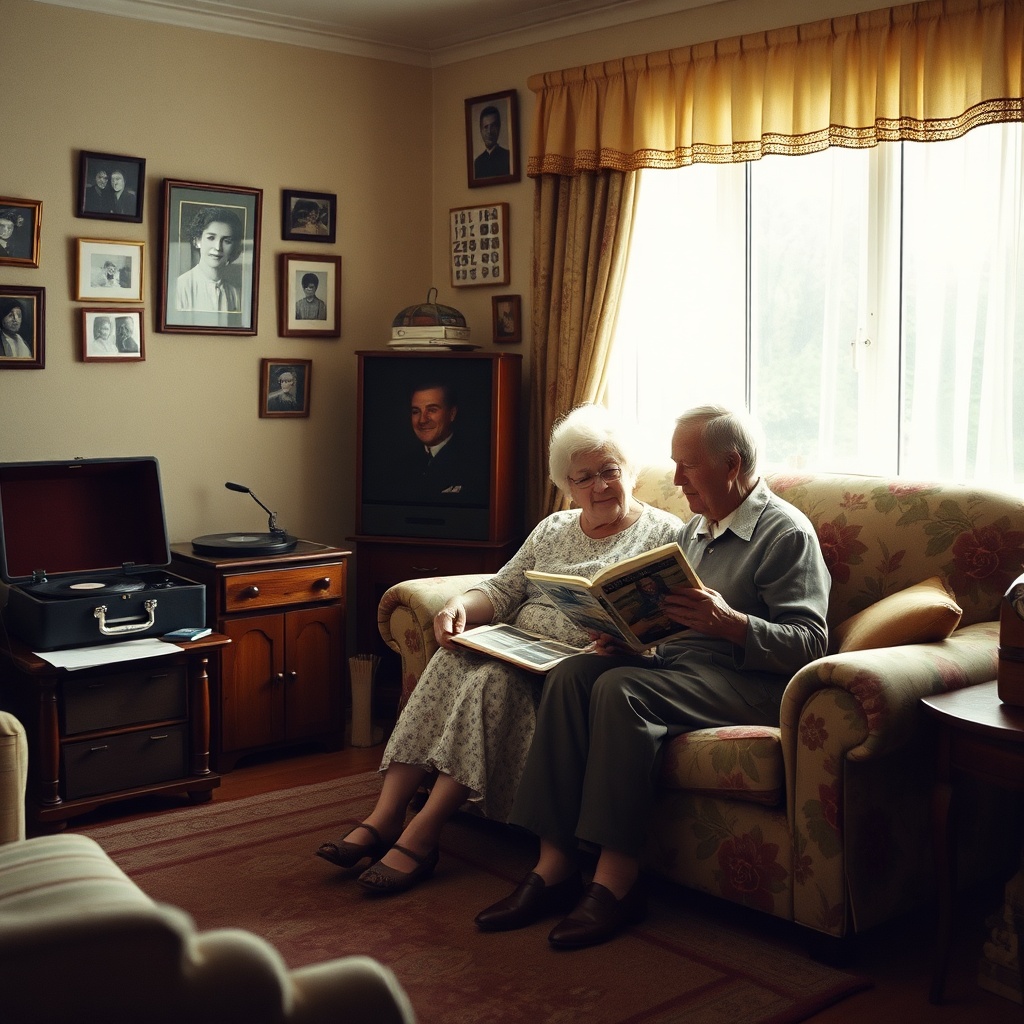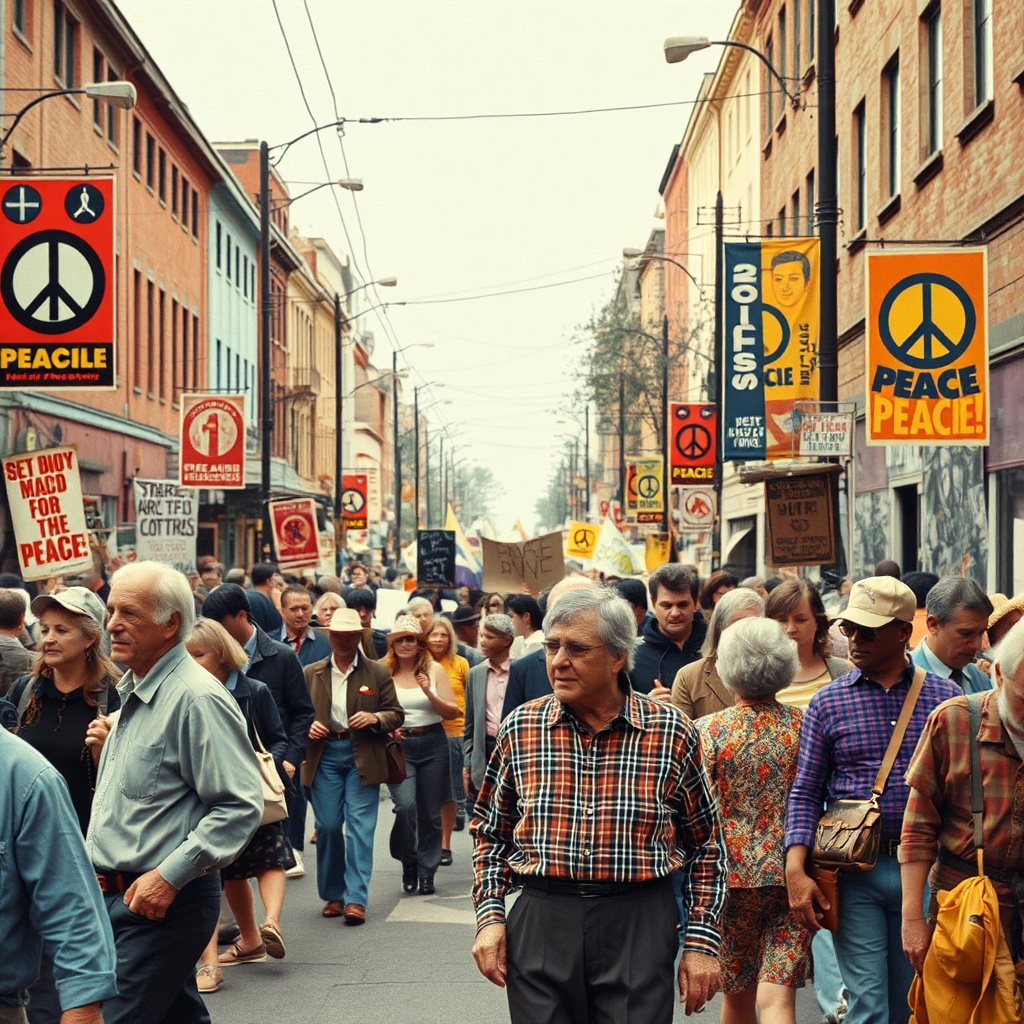Revisiting the Spirit of Change: What Fueled the 1960s Revolution?

Exploring the Context of Change
The 1960s was a decade marked by significant social, political, and cultural upheaval. It was a time when individuals sought to challenge the status quo, leading to movements that reshaped society. Let’s delve into the key factors that fueled this transformative revolution.
Key Influences of the 1960s Revolution
- Political Turbulence: The Vietnam War sparked widespread protests. Many young people questioned government decisions and took to the streets to voice their dissent.
- Civil Rights Movement: The fight for racial equality gained momentum. Figures like Martin Luther King Jr. inspired millions to stand against segregation and injustice.
- Counterculture Movement: The rise of the hippie movement challenged traditional norms. People embraced peace, love, and communal living, advocating for a more liberated lifestyle.
- Women’s Liberation: The struggle for gender equality began to take center stage. Women demanded equal rights, leading to significant changes in legislation and societal attitudes.
- Technological Advancements: The advent of television and mass media played a crucial role in disseminating revolutionary ideas, making information more accessible to the public.
The Role of Music and Art
Art and music were central to the 1960s revolution. They served as powerful mediums for expressing discontent and hope. Iconic musicians like Bob Dylan and The Beatles used their platforms to promote messages of peace and change.
| Artist | Song | Message |
|---|---|---|
| Bob Dylan | “The Times They Are A-Changin’” | Call for social change and awareness |
| John Lennon | “Imagine” | Vision of a peaceful world |
Personal Stories: Voices from the Era
Engaging with those who lived through the 1960s can provide invaluable insights. Consider reaching out to friends or community members who experienced this era. Ask them:
- What events had the most impact on them?
- How did their views change during the decade?
- What role did music or art play in their lives?
Reflection and Legacy
The legacy of the 1960s revolution continues to resonate today. Many of the battles fought during this era laid the groundwork for ongoing movements for equality and justice. Reflecting on this transformative time can inspire current and future generations to continue the fight for change.
What do you think? How did the 1960s influence your life? Share your thoughts and memories with those around you.
Voices of the Past: Personal Stories from the 1960s Era

As we delve into the 1960s, a decade marked by profound change and cultural upheaval, we invite you to reflect on personal stories and experiences from those who lived through it. This era was not just about movements and protests; it was about real people and their voices.
Personal Stories
Let us explore some touching narratives that capture the essence of the 1960s:
1. The March on Washington
Mary Johnson, a young activist, recalls her journey to Washington D.C. in 1963:
“I remember the excitement buzzing in the air as we gathered. We were not just a crowd; we were a family united by hope. I still hear Dr. King’s words ringing in my ears, urging us to dream of a better tomorrow.”
2. The Influence of Music
James Carter, a passionate musician, shares his experience:
“The music we created was our voice. From the Beatles to Bob Dylan, every song carried a message. We were not just entertainers; we were revolutionaries.“
3. The Women’s Liberation Movement
Linda Thompson, a trailblazer in the women’s rights movement, reflects on her journey:
“We stood together, demanding equality and respect. Our voices mattered, and we made sure they were heard. I still feel the adrenaline of those rallies, the sense of purpose that drove us forward.”
4. The Counterculture Movement
Tommy Lee, a member of the counterculture, shares his perspective:
“We sought freedom in every aspect of life. From fashion to philosophy, we challenged the norms. The Summer of Love was not just a season; it was a movement of the heart.“
These personal stories are but a glimpse into the diverse experiences of the 1960s. Each narrative holds a piece of history, reminding us of the struggles and triumphs that shaped our world. What stories do you hold from this transformative era?
The Cultural Renaissance: How Music and Art Shaped a Generation

The Cultural Renaissance of the 1960s
The 1960s were not just a decade; they were a cultural renaissance that transformed the landscape of music and art in profound ways. This era saw the emergence of powerful voices and vibrant expressions that resonated with the aspirations and struggles of a generation. Let’s take a closer look at how music and art shaped this transformative period.
Music: The Soundtrack of Change
Music became the heartbeat of the 1960s, echoing the desires for freedom, peace, and social justice. Artists like Bob Dylan, The Beatles, and Janis Joplin not only entertained but also inspired action and reflection.
- Folk Music: With its roots in social commentary, folk music provided a voice for the civil rights movement and anti-war protests. Dylan’s “Blowin’ in the Wind” and “The Times They Are A-Changin’” became anthems of change.
- Rock and Roll: The explosion of rock music brought energy and rebellion. The Beatles revolutionized popular music, while bands like The Rolling Stones encapsulated the spirit of defiance.
- Counterculture Festivals: Events like Woodstock in 1969 symbolized peace, love, and unity, drawing hundreds of thousands to celebrate music and counterculture ideals.
Art: A Canvas for Expression
While music stirred emotions, art provided a visual language that challenged societal norms and pushed boundaries.
- Pop Art: Artists like Andy Warhol and Roy Lichtenstein blurred the lines between high art and commercial culture, reflecting consumerism and mass media.
- Abstract Expressionism: This movement, led by figures such as Jackson Pollock and Mark Rothko, emphasized spontaneity and emotion, resonating with the chaotic nature of the decade.
- Street Art: Graffiti and murals became powerful tools for political expression, conveying messages of resistance and hope in urban landscapes.
Interactive Reflections
As you reflect on this vibrant era, consider the following:
- What songs from the 1960s resonate with you the most? Why?
- How did the art of the 1960s influence your views on society?
- Were there specific events or festivals you attended that left a lasting impression?
The Legacy of the 1960s
The cultural renaissance of the 1960s continues to influence music, art, and activism today. Its legacy is a testament to the power of creative expression in shaping societal change. As we look back, we celebrate the voices that dared to challenge the status quo and inspire generations to come.
From Protest to Progress: The Legacy of the 1960s Social Movements
The 1960s was a decade marked by profound social upheaval, where the cries for justice rang out across the globe. This era saw ordinary citizens rise up, demanding change. Have you ever reflected on how these movements shaped the society we live in today?
The Spark of Activism
It all began with a sense of discontent. The civil rights movement, fueled by the courageous efforts of individuals like Martin Luther King Jr. and Rosa Parks, ignited a passion for equality. Did you participate in any demonstrations or observe them from afar?
A Closer Look at Major Movements
| Movement | Key Figures | Goals |
|---|---|---|
| Civil Rights Movement | Martin Luther King Jr., Rosa Parks, Malcolm X | End racial segregation and discrimination |
| Anti-Vietnam War Movement | Abbie Hoffman, Jane Fonda | Oppose U.S. involvement in Vietnam |
| Women’s Liberation Movement | Betty Friedan, Gloria Steinem | Achieve gender equality and reproductive rights |
| Environmental Movement | Rachel Carson | Raise awareness about environmental issues |
Transformation Through Protest
These movements led to significant legislative changes. For instance, the Civil Rights Act of 1964 and the Voting Rights Act of 1965 were direct outcomes of relentless activism. Can you recall any specific changes in your community during that time?
The Role of Media
The media played a pivotal role in these movements. With the rise of television, images of protests and marches brought the struggles of many into the living rooms of Americans. How did this visibility impact your perception of social issues?
The Legacy of the 1960s Movements
Today, the seeds planted during the 1960s continue to grow. Movements for racial justice, gender equality, and environmental protection draw inspiration from this transformative decade. Have you seen parallels in contemporary social movements?
Reflection and Discussion
As we reflect on the legacy of the 1960s, it’s essential to engage in conversations about progress. What lessons do you think the younger generations can learn from the struggles and victories of that era?
The 1960s was not just a decade of protests; it was a foundation for progress. The legacy of social movements continues to influence our world today. What are your thoughts on the current state of social justice?
The Power of Unity: How Communities Came Together in the 1960s
During the 1960s, a remarkable wave of unity swept across communities in the United States and beyond. This era was characterized by a collective endeavor to address societal issues such as civil rights, anti-war sentiments, and cultural revolutions. Let’s delve deeper into how communities came together during this transformative decade.
Grassroots Movements and Their Impact
One of the most significant aspects of the 1960s was the rise of grassroots movements. These movements were often initiated by ordinary citizens who sought to bring about change. Communities recognized the power of collective action and rallied together for various causes.
The Civil Rights Movement
The Civil Rights Movement was a pivotal part of the 1960s, where diverse groups united to fight against racial injustice.
Key Events:
| Year | Event | Outcome |
|---|---|---|
| 1963 | March on Washington | Over 250,000 participants demanded civil and economic rights. |
| 1964 | Civil Rights Act | Prohibited discrimination based on race, color, religion, sex, or national origin. |
| 1965 | Voting Rights Act | Eliminated barriers to voting for African Americans. |
This movement showcased how communities, regardless of their backgrounds, stood together in solidarity, challenging the status quo and promoting equality.
Anti-War Protests
The Vietnam War sparked widespread protests, uniting people across the nation in their opposition to the conflict.
Notable Protests:
| Year | Event | Location |
|---|---|---|
| 1965 | March Against the Vietnam War | Washington, D.C. |
| 1969 | Moratorium to End the War in Vietnam | Nationwide |
| 1971 | Winter Soldier Investigation | Detroit, MI |
These protests illustrated the strength of unity as young people, veterans, and concerned citizens came together, voicing their desire for peace.
Cultural Movements
The 1960s also saw the emergence of countercultural movements that challenged societal norms.
Key Cultural Movements:
| Movement | Description |
|---|---|
| Feminism | Women rallied for equal rights and opportunities. |
| Environmentalism | Communities advocated for the protection of the environment. |
| Counterculture | A youth-driven movement promoting peace, love, and cultural expression. |
These cultural shifts were a testament to how communities bonded over shared ideals, creating lasting impacts on society.
Conclusion: The Legacy of Unity
The 1960s was an era where the strength of community and collective action became clear. Through united efforts, individuals transformed their societies, leaving behind lessons on the importance of collaboration and solidarity. As we reflect on this transformative period, it serves as a reminder of what can be achieved when communities come together for a common cause.
Lessons Learned: What the 1960s Teach Us About Today’s Challenges
Understanding the 1960s
The 1960s was a decade marked by profound social, political, and cultural upheaval. From the civil rights movement to anti-war protests, this era reshaped the landscape of modern society. As we navigate today’s challenges, reflecting on the lessons from the 1960s can provide invaluable insights.
Key Lessons from the 1960s
| Lesson | Description |
|---|---|
| Unity and Solidarity | Movements during the 1960s demonstrated the power of collective action. Diverse groups came together to advocate for civil rights, women’s rights, and peace. |
| Importance of Activism | The decade highlighted how grassroots activism can lead to significant change. Individuals took to the streets, organized protests, and demanded justice. |
| Questioning Authority | People began to challenge established norms and authority. This questioning led to reforms and a re-evaluation of societal values. |
| Media Influence | Television and print media played crucial roles in shaping public opinion and spreading awareness about injustices. |
Applying These Lessons Today
Now, as we face issues like climate change, economic inequality, and political polarization, the lessons from the 1960s remain relevant:
Engage in Community: Just as communities banded together in the 60s, today’s challenges require collective efforts.
Be Informed: Stay aware of current events and educate others. Knowledge is power.
Advocate for Change: Whether it’s through voting, peaceful protests, or community service, every action counts.
Utilize Media: Use social media and other platforms to raise awareness and mobilize support for important causes.
Interactive Reflection
Consider your experiences during the 1960s. How did those events shape your views today? Engaging with others can foster understanding and inspire action.
Reflect on the following questions:
What movements did you participate in, and what motivated you?
How did the media influence your perspective back then?
What changes do you hope to see in today’s society?
The 1960s taught us that change is possible when individuals unite for a common cause. By applying these lessons, we can address today’s challenges with the same vigor and commitment.
Icons of Change: Celebrating the Leaders of the 1960s Revolution
Understanding the 1960s Revolution
The 1960s was a decade of profound change and upheaval. It was a time when the voices of a new generation rose to challenge the status quo, advocating for civil rights, peace, and freedom. This era was marked by iconic leaders whose actions and ideologies shaped not only the decade but the future of generations to come.
Key Leaders Who Shaped the Decade
| Leader | Movement | Key Contributions |
|---|---|---|
| Martin Luther King Jr. | Civil Rights Movement | Advocated for nonviolent protest and delivered the iconic ‘I Have a Dream’ speech which galvanized public support for civil rights. |
| Malcolm X | Black Nationalism | Pushed for racial pride and empowerment, advocating for a more militant approach to civil rights. |
| Rosa Parks | Civil Rights Movement | Refused to give up her bus seat, sparking the Montgomery Bus Boycott and becoming a symbol of resistance. |
| John Lennon | Anti-War Movement | Used his platform as a member of The Beatles to promote peace and protest against the Vietnam War. |
| Betty Friedan | Women’s Liberation Movement | Authored ‘The Feminine Mystique’ and co-founded the National Organization for Women, advocating for women’s rights. |
Think back to those times. What do you remember about the leaders of the 1960s? How did they inspire you? Consider the following questions:
Which leader’s message resonated with you the most?
How did their actions influence the community around you?
What lessons from their leadership can we apply today?
Legacy of the 1960s Leaders
The leaders of the 1960s revolution left a lasting legacy that continues to inspire movements for equality and justice. Their courage and commitment to change remind us that one voice can make a difference.
As we celebrate these icons of change, we invite you to share your stories and reflections on their impact. How have their contributions shaped your views and experiences over the years?
Fashion and Freedom: The Style that Defined an Era
The 1960s was a decade marked by radical change, not just in politics and society, but also in the realm of fashion. This era was a canvas for self-expression and rebellion, where clothing became a powerful symbol of freedom and identity. Let’s explore how fashion mirrored the spirit of the times.
The Boldness of the 60s Fashion
Mini Skirts and Mod Culture: The emergence of the mini skirt was a bold statement against traditional norms. Designers like Mary Quant popularized this daring style, giving women the freedom to express themselves in ways previously unimaginable. Do you remember the first time you wore a mini skirt?
Colors and Patterns
The 60s were vibrant—think psychedelic patterns and bright colors. Fashion icons like Twiggy and bands like The Beatles embraced these eye-catching designs. The use of color was not just aesthetic; it was a way to challenge the status quo. What colors do you associate with the 60s?
Unisex Fashion and the Rise of Youth Culture
As the youth culture began to take center stage, fashion became more unisex. Styles that blurred gender lines were embraced, allowing individuals to dress for comfort and self-expression rather than societal expectations. This shift was revolutionary. How did this change your way of dressing?
Fashion Icons of the Era
| Icon | Contribution |
|---|---|
| Mary Quant | Invented the mini skirt, symbolizing freedom for women |
| Twiggy | Defined the ‘Mod’ look with her androgynous style |
| Jackie Kennedy | Influenced American fashion with her elegance and sophistication |
| Jimi Hendrix | Introduced flamboyant styles and colors to men’s fashion |
These icons not only influenced fashion but also shaped cultural attitudes. Which fashion icon inspired you the most?
The Influence of Music on Fashion
Music played a crucial role in shaping the fashion landscape. The rise of rock and roll and folk music led to new styles. As artists expressed their beliefs through their music, their fashion choices became a reflection of their messages. Can you recall a song that brought back memories of the 60s fashion?
Conclusion: The Legacy of 60s Fashion
Fashion in the 1960s was not just about clothing; it was a movement that represented freedom, rebellion, and self-expression. The styles from this era continue to influence today’s fashion. Reflecting on this transformative time can remind us of the power of clothing as a medium for change. What lasting impact do you think the 60s fashion had on today’s trends?
A Journey Through Time: Key Events that Shaped the 1960s
Welcome to a captivating exploration of the 1960s, a decade that witnessed profound transformations across various spheres of life. This period was marked by significant events that reshaped society, politics, culture, and civil rights. Let’s embark on a journey through time and revisit the key milestones that defined this remarkable era.
One of the most pivotal movements of the 1960s was the Civil Rights Movement, which sought to end racial segregation and discrimination against African Americans.
- 1954: The landmark Supreme Court decision in Brown v. Board of Education declared segregated schools unconstitutional.
- 1963: The March on Washington for Jobs and Freedom, where Martin Luther King Jr. delivered his iconic “I Have a Dream” speech.
- 1964: The Civil Rights Act was passed, prohibiting discrimination based on race, color, religion, sex, or national origin.
- 1965: The Voting Rights Act aimed to eliminate barriers to voting for African Americans.
The Vietnam War
The Vietnam War was a significant conflict that deeply polarized American society. It sparked widespread protests and raised questions about U.S. involvement in foreign wars.
- 1964: The Gulf of Tonkin incident prompted Congress to pass the Gulf of Tonkin Resolution, escalating U.S. military involvement.
- 1968: The Tet Offensive, a series of surprise attacks by North Vietnamese forces, shifted public opinion against the war.
- 1973: The Paris Peace Accords led to the withdrawal of U.S. troops from Vietnam.
Counterculture and the Hippie Movement
The 1960s also saw the rise of the counterculture, characterized by a rejection of traditional values and an embrace of alternative lifestyles.
- 1967: The Summer of Love in San Francisco became a symbol of the hippie movement, promoting peace, love, and music.
- 1969: The Woodstock Festival celebrated music and counterculture, attracting hundreds of thousands of attendees.
- 1968: The Democratic National Convention in Chicago became a battleground for political protests, highlighting the era’s social unrest.
Women’s Liberation Movement
The Women’s Liberation Movement gained momentum during the 1960s, advocating for gender equality and women’s rights.
- 1963: The publication of Betty Friedan’s The Feminine Mystique challenged traditional gender roles.
- 1966: The formation of the National Organization for Women (NOW) aimed to advocate for women’s rights.
- 1972: Title IX was enacted, prohibiting sex-based discrimination in federally funded education programs.
The 1960s were a decade of change, where the echoes of revolution continue to resonate in today’s society. Each event played a crucial role in shaping the course of history, and the legacies of this era remain influential. Reflect on these key moments and consider how they have impacted your life and the world around you.
Reflections on Resistance: The Role of Activism in the 1960s
The Landscape of Activism in the 1960s
The 1960s were a decade marked by profound changes and significant social upheaval. Activism emerged as a powerful force during this time, driven by a desire for justice and equality. Many individuals and groups rose up to challenge the status quo, advocating for civil rights, peace, and social reforms. Can you recall any specific events or figures that inspired you during this transformative era?
Key Movements and Their Impact
Several key movements defined the activism of the 1960s, each contributing to the larger narrative of resistance:
- Civil Rights Movement: This movement aimed to end racial segregation and discrimination against African Americans. Key figures such as Martin Luther King Jr. and Rosa Parks led peaceful protests that galvanized national attention.
- Anti-Vietnam War Protests: As the conflict escalated, many Americans began to question the morality of U.S. involvement. Large demonstrations, like the one at Washington D.C. in 1969, drew thousands of activists.
- Women’s Liberation Movement: Women began to demand equal rights, including reproductive rights and workplace equality. The publication of The Feminine Mystique by Betty Friedan sparked widespread discussion.
Notable Figures in Activism
Many individuals became symbols of resistance during the 1960s. Here are a few notable activists who left a lasting legacy:
| Name | Contribution | Impact |
|---|---|---|
| Martin Luther King Jr. | Leader of the Civil Rights Movement | Promoted non-violent protest, leading to significant legislative changes. |
| Malcolm X | Advocate for Black empowerment | Encouraged self-determination and inspired many to fight for their rights. |
| Abbie Hoffman | Co-founder of the Youth International Party | Used humor and theatricality to draw attention to anti-establishment sentiments. |
| Betty Friedan | Author and activist | Challenged traditional gender roles, leading to the second wave of feminism. |
The Legacy of 1960s Activism
The activism of the 1960s laid the groundwork for future generations. The struggles and victories of this era continue to influence contemporary movements. Think about the issues we face today—how do they connect to the activism of the 1960s? For example:
- Social Justice: Movements like Black Lives Matter echo the calls for racial equality.
- Environmentalism: The origins of the modern environmental movement can be traced back to protests in the 1960s.
- Women’s Rights: The fight for equal pay and reproductive rights remains a pressing issue.
Engaging with Activism Today
As we reflect on the past, consider how we can engage with activism today. Here are some ways you can get involved:
- Educate Yourself: Read books or watch documentaries about the 1960s and the movements that shaped modern society.
- Participate: Join local groups or initiatives that promote social change in your community.
- Advocate: Use your voice to support causes that matter to you, whether through writing, speaking, or volunteering.
What does activism mean to you? How have your experiences shaped your understanding of resistance? Share your thoughts and reflections with others to keep the spirit of the 1960s alive.
